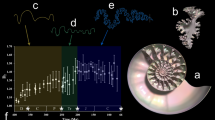Abstract
The model supposes that sub-hemispheric septa of deep-water cephalopods evolved transverse pillars by meridional fluting in order to support flat and therefore weak areas of the shell wall. Several trends toward reduction of sutural spacing for improved wall support resulted in rise of fluting and finally, marginal crenulation. During ontogeny, the function of the ammonite septum as complex vault system against ”normal“ pressure from the body was succeeded by compound-pillar function for wall support. Fabrication of ammonitic septa probably involved positive pressure differential of new ”cameral“ liquid, orientation of mantle fibers along stress lines, and successively affixed tie-points which lay on an aponeurosislike mantle structure.
Zusammenfassung
Das Modell nimmt an, daß subhemisphärische Septen von Tiefsee-Cephalopoden phylogenetisch transversale Pfeiler durch meridionale »Faltung« (fluting) entwickelten, um flache und daher schwache Teile der Schalenwand zu unterstützen. Mehrere Trends zur Verminderung des Suturabstandes für verbesserte Wandabstützungen resultieren in vergrößerter Faltungshöhe und schließlich randlicher Krenulierung des Septums. Das ammonitisene Septum funktionierte ontogenetisch zuerst als komplexes Gewölbe gegen Körperdruck, dann ais Bündelpfeiler für Wandabstützung. Die Fabrizierung des Ammonitenseptums wurde wahrscheinlich durch positiven Druckunterschied der neuen Kammerflüssigkeit, Ausrichtung der Mantelfasern nach den Drucklinien und nacheinander befestigte Haftpunkte entlang einer Aponeurosis-ähnlichen Mantel-Struktur unterstützt.
Similar content being viewed by others
References
Currey, J. D. &Taylor, J. D. (1974): The mechanical behaviour of some molluscan hard tissues. — J. Zool. (London),173: 395–406.
Erben, H. K. (1964a): Die Evolution der ältesten Ammonoidea (Lieferung I). — N. Jb. Geol. Paläont., Abh.120: 107–212.
Erben, H. K. (1964b): Bactritoidea. — [In:] Treatise of Invertebrate Paleontology,R. C. Moore, Ed., Part K, Mollusca 3, K 491—K 505. Geol. Soc. Amer, and Univ. Kansas Press.
Gould, S.J. (1970): Evolutionary paleontology and the science of form. — Earth Science Rev.,6: 77–119.
Gregoire, Ch. (1967): Sur la structure des matrices organiques des coquilles des mollusques. — Biol. Rev.,42: 653–688.
Hillebrandt, M. (1974): Analysis of vertebrate structure. — J.Wiley & Sons, Toronto.Jordan, R. (1968): Zur Anatomie mesozoischer Ammoniten nach den Strukmrelementen der Gehäuse-Innenwand. — Beih. Geol. Jb.,77: 1–64, pl. 1—10.
Mutvei, H. &Reyment, R. A. (1973): Buoyancy control and siphuncle function in ammonoids. — Palaeontology,16: 623–636.
Newell, N. D. (1949): Phyletic size increase, an important trend illustrated by fossil invertebrates. — Evolution,3: 103–124.
Pfaff, E. (1911): über Form und Bau der Ammonitensepten und ihre Beziehungen zur Suturlinie. — Jber. niedersächs. geol. Ver. Hannover (Geol. Abt. Naturhist. Ges. Hannover),4: 207–223.
Raup, D. M. (1972): Approaches to morphologic analysis. — [In:] Models in Paleobiology,T. J. M. Schopf, Ed., 28–44. Freeman, Cooper & Co., San Francisco.
Rudwick, M. J. S. (1964): The inference of function from structure in fossils. — Brit. J. Phil. Sci.,15: 27–40.
—— (1970): Living and fossil brachiopods. — [In:] Biol. Scis.,A. J. Cain, Ed., 199 p. Hutchinson Univ. Libr., London.
Schmidt, M. (1925): Ammonitenstudien. — Fortschr. Geol. Paläont.,10, I—IV: 275–363.
Seilacher, A. (1970): Arbeitskonzept zur Konstruktionsmorphologie. — Lethaia,3: 393–396.
—— (1974): Fabricational noise in adaptive morphology. — System. Zool.,22: 451–461.
Spath, C. F. (1919): Notes on ammonites. — Geol. Mag.,56: 27–35, 65—74, 115—122, 170 bis 177, 220—225.
Stenzel, H. B. (1964): Living Nautilus. — [In:] Treatise on Invertebrate Paleontology,R. C. Moore, Ed., K, Molluska 3, K 59—93.
Swinnerton, H. H. (1918): The morphology and development of the ammonite septum. — Geol. Soc. London, Quart. J.,73: 26–57.
Taylor, J. D. &Layman, M. (1972): The mechanical properties of bivalve (Mollusca) shell structures. — Palaeontology,15: 73–87.
Thompson, d’A. W. (1942): On growth and form. — 1116 p. Cambridge Univ. Press and Macmillan Co.
Westermann, G. E. G. (1956): Phylogenie der Stephanocerataceae und Perisphinctaceae des Dogger. — N. Jb. Geol. Paläont. Abh.103: 233–279.
—— (1958): The significance of septa and sutures in Jurassic ammonite systematics. — Geol. Mag.,95: 441–455.
—— (1965): Septal and sutural patterns in evolution and taxonomy of Thamboceratidae and Clydoniceratidae (M. Jurassic, Ammonitina). — J. Paleont.,39: 864–874.
—— (1971): Form, structure and function of shell and siphuncle in coiled Mesozoic amraonoids. — Royal Ontario Museum, Life Sci. Contr.,78: 1–39. Toronto.
—— (1972): The case of alleged inversion of septal sutures in ammonites. — Lethaia5: 165–167.
—— (1972) Strength of concave septa and depth limits of fossil cephalopods. — Lethaia,6: 383 bis 403.
Author information
Authors and Affiliations
Rights and permissions
About this article
Cite this article
Westermann, G.E.G. Model for origin, function and fabrication of fluted cephalopod septa. Paläontol. Z. 49, 235–253 (1975). https://doi.org/10.1007/BF02987661
Received:
Issue Date:
DOI: https://doi.org/10.1007/BF02987661




